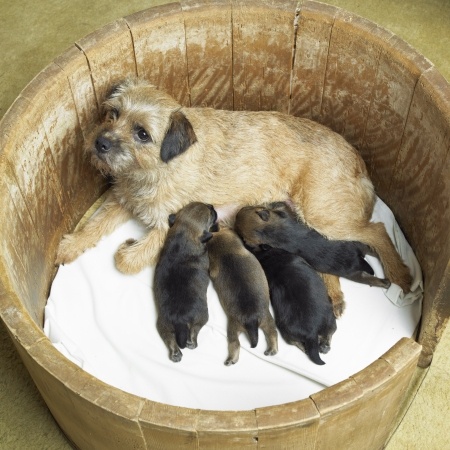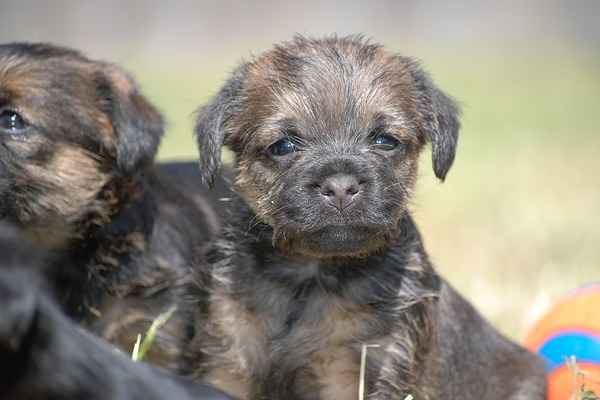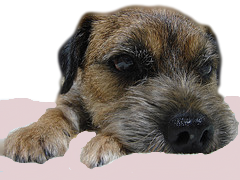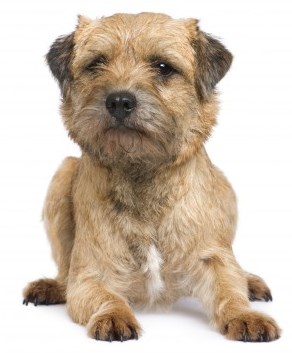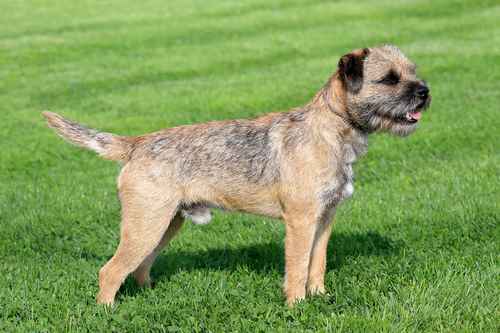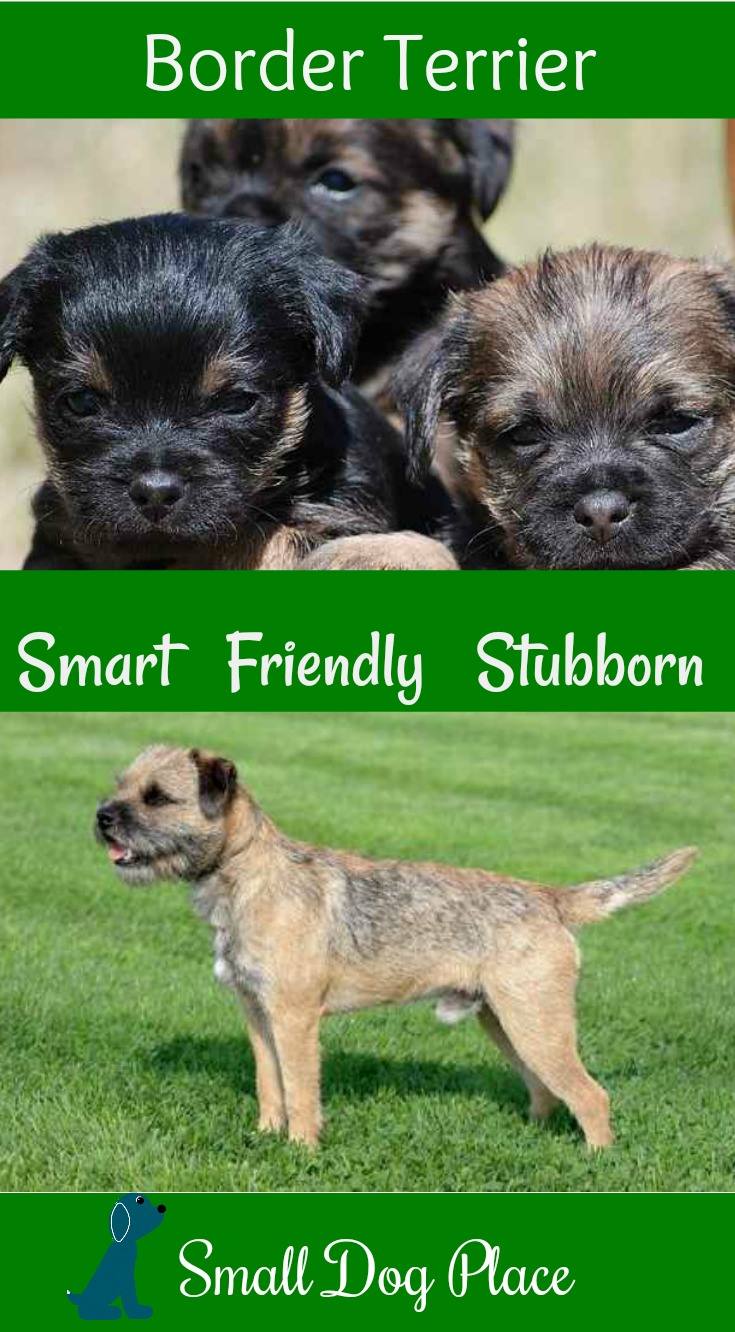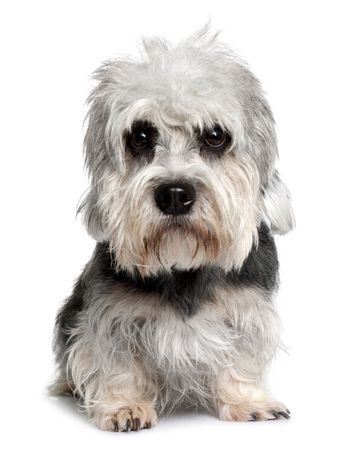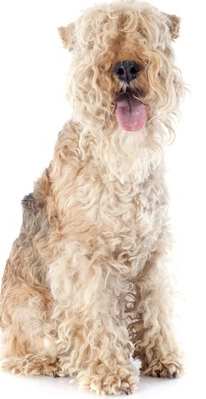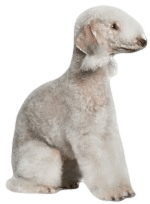- Small Dog Place Home
- A-Z Breeds A to M
- Border Terriers
Border Terriers:
Gotta Love that Terrier Personality
Border Terriers by Janice Jones |Last Updated 11-30-2022
Oh, those adorable Border Terriers? What's not to love when you meet that cute face, friendly nature, and playful disposition of a Border Terrier puppy.
Being highly photogenic, it often seems they are performing for the camera. But don’t let that puppy dog look fool you.
They are terrier through and through and will need exercise, training and socialization if you are planning to get one for your apartment.
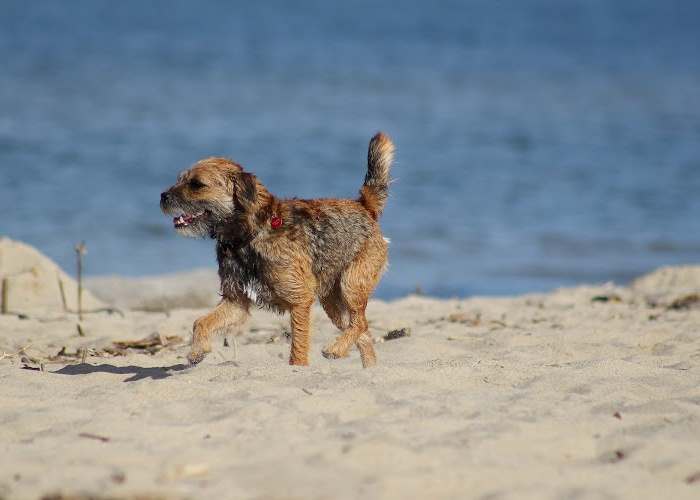
They are fast learners, but as far as training is concerned, they can be rather suborn, and if there is something else that looks more appealing, such as a rabbit bouncing through the grass, or scent of your neighbor’s cat, you are likely to lose their attention.
The perfect owner is one who is willing to keep their Border mentally and physically challenged.
As they say, an “Untrained dog is a danger to himself as well as others.”
Some of their inborn traits include the tendency to jump, chase, chew, and dig. For this reason, Border Terriers should not be allowed outdoors unattended. Even in a securely fenced yard, they have been known to dig their way to freedom or jump the fence.
They have a strong prey drive which makes chasing small animals irresistible to the average Border Terrier.
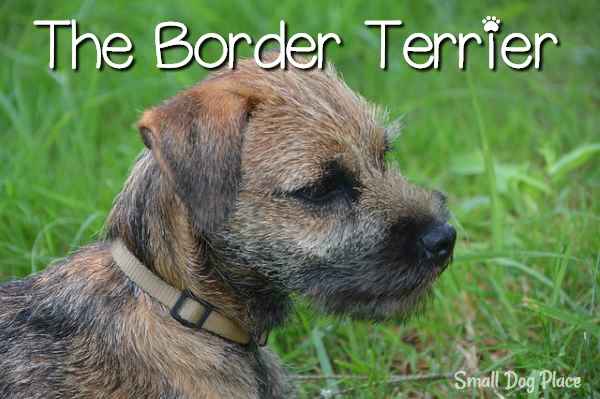
Since they seem to have little fear or attention to cars, many are killed running into an oncoming car.
Border Terriers also love to chew as all dogs do, but because of their breeding, Borders never seem to outgrow their need to chew, whether its rugs, chair legs or anything that is within reach.
Sturdy chew toys are a must for this breed’s strong jaws and teeth.
Quick Facts About Border Terriers
Other Names Used: Borders
Affiliation:
AKC: Terrier, KC: Terrier, CKC: Terrier
Height: 10 inches (25cm)
Weight
Males: 13 to 15 ½ pounds (6-7 kg)
Females: 11 ½ to 14 pounds (5-6 kg)
Coat Type: Double-coated: harsh and dense outer coat with a close, soft undercoat
Colors: Red, wheaten, grizzle, and tan, or combinations
Country of Origin: Great Britain
Activity Level:
Moderately Active
Life Expectancy: Up to 16 years
Good with Children: Yes if supervised
Good with other pets: OK with other dogs or cats if socialized early, not small pets
History
The history of the breed dates back to the 19th century when these dogs were known as the Reedwater or the Coquetdale Terrier, after the places where these dogs were first used.
It is thought that the Border, Bedlington, and Dandie Dinmont Terriers all arose from the same ancestor.
Now the breed is called the Border terrier because this is an area on either side of the Cheviot Hills, known as the Border country or the area between England and Scotland. There farmers relied on their sheep and wild game for their food sources and the two major problems to their subsistence was foxes and vermin.
The terriers of the day were purely working dogs trained to flush out foxes after a pack of foxhounds chased the fox underground and keep the vermin population under control.
Never bred for looks, but only performance ability, Border Terriers were perfectly suited for the job, physically strong and rigorous with a wiry weather resistant coat, able to withstand the elements.
There was never any attempt to breed for color, size, leg length or coat type. Since these dogs had longer legs than some of the shorter leg Scottish breeds, it made them ideal for following a horse and dog pack and scrambling down a fox hole.
Their real value to the early farmers was their ability to catch fox and control vermin.
It was to this end that they were bred.
Farmers were not likely to feed them, so they had to be excellent hunters to survive.
Today, they are first and foremost companion dogs.
But we use them today for most anything from competition to therapy.
Their versatility allows them to participate in a wide variety of these sports: earth dog, obedience, rally, agility, flyball and tracking.
It was first recognized in the UK by the Kennel Club in 1920. Only after this recognition did the Border terrier become better known.
Previously, for the most part, the breed was known only in agricultural settings in the Border country.
In 1930, they were recognized by the AKC and continue to remain extremely popular in England today.
Personality of Border Terriers
First and foremost, Border Terriers are terriers through and through. They are friendly, even tempered and rarely aggressive.
Even though they were bred to be a working dog, they love people and make excellent pets if their owners provide the exercise and stimulation that they require.
They do have a stubborn streak which is common in many small breeds and can be strong willed at times.
Maintaining many of the traits bred into them, they are intelligent, independent by nature and easily trainable. They have excelled in agility and even do well as therapy dogs.
Did you know…?
‘Terrier’ comes from the Latin word terra, meaning ‘earth’.
Given its strong hunting instinct, they do not always do well with small pets such as rabbits, guinea pigs or hamsters.
If raised with cats, they do fine, but if a new cat is introduced into the family when the Border is full grown, beware. Most Borders do fine around other dogs, assuming they have been properly socialized and trained at an early age.
They make good family pets and do fine around children providing the children have been taught how to respect and treat the dog.
Above all else, they want to be part of their owner’s life and are not happy being left alone for long periods of time.
When reuniting with their beloved human at the end of the day, they are likely to put on a show of jumps, kisses, and barks, so effusive that it is hard to contain.
While not considered to be a yappy breed, they will bark to warn you if someone is at the door, making them a good watch dog, but not a guard dog.
| Traits | Rating |
|---|---|
| Playfulness | |
| Affection Level | |
| Friendliness Towards Strangers | |
| Good with Children | |
| Good with Other Dogs | |
| Good for First Time Owners | |
| Exercise Needed | |
| Ease of Training | |
| Watch Dog Ability | |
| Grooming Requirements | |
| Shedding | |
| Cold Tolerant | |
| Heat Tolerant |
Dog Breed Ratings Got You a Little Confused?
Here's a little help in understanding them
- Playfulness: Most Playful = 5 Least Playful = 1
- Affection: Most Affectionate = 5 Least Affectionate = 1
- Friendliness Towards Strangers: Most Friendly = 5 Least = 1
- Good With Children: Great= 5 Not Good with Children = 1
- Good With Dogs: Great = 5 Not Good Around Dogs = 1
- Good With First Time Owners: Fine=5 Not Appropriate = 1
- Exercise Required: Extensive Daily Exercise = 1 Minimal = 1
- Ease of Training: Very Easy = 5 Difficult = 1
- Watch Dog: Excellent Watch Dog = 5 Minimal = 1
- Grooming: Time Consuming = 5 Minimal = 1
- Shedding: Heavy Shedder = 5 Minimal = 1
- Cold Tolerance: Well Tolerated = 5 Poor Tolerance = 1
- Heat Tolerance: Well Tolerated = 5 Poor Tolerance = 1
Grooming
Border Terriers, like many terrier breeds, need to be ‘stripped’ twice a year to keep their coats looking great.
It is recommended that they not be clipped or scissored. They are a shedding breed and will shed hair continually throughout the year.
An all-over brushing once a day will keep loose hair from finding its way to all corners of your home.
Their harsh coat tends to repel dirt, so frequently bathing is not necessary. A bath, every 3 to 4 weeks, is recommended, and nails will need to be clipped about that often, as well.
Teeth should be brushed daily if possible and anal glands checked periodically and expressed if needed.
Other than that, the breed is relatively low maintenance when it comes to grooming them.
Health Concerns of Border Terriers
This is a relatively healthy breed, but as all small dogs, they are prone to some genetic disorders.
Good veterinary preventative care keeps Borders free of diseases. Like all small breed dogs, there are some Genetic problems that occasionally show up.
Among those found in Borders include the following disorders:
Heart defects
PRA (Progressive retinal atrophy)
Juvenile Cataracts (forms of blindness)
Bite malocclusion
These problems have not become widespread in the breed because of careful, selective breeding.
Border Terriers are very fond of eating and can become overweight easily if their diet is not monitored.
Pros:
- Great all round family dog
- Intelligent and quick to learn
- Loyal and affectionate
- Good Watch dog
- Can adjust to a variety of lifestyles
- Medium maintenance when it comes to grooming
Cons
- Stubborn
- Independent nature may pose problems during training
- Requires training and socialization
- Doesn’t do well around other small family pets (hamsters, gerbils)
- Fierce chase instinct means he must be contained within a fence or leashed
For More Information on the Border Terrier
Border Terrier Club of America
If you are considering adopting or purchasing a Border Terrier, I highly recommend that you do some further reading. These books sold by Amazon can be purchased directly from this site and I do get a small commission each time a sale is made. I appreciate your help in keeping this site up and growing.
You May Want to Check Out these Other Similar Small Breed Dogs...
About Janice (author and voice behind this site)
Having lived with dogs and cats most of her life, Janice served as a veterinary technician for ten years in Maryland and twelve years as a Shih Tzu dog breeder in Ohio.
Her education includes undergraduate degrees in Psychology with a minor in biology, Early Childhood Education, and Nursing, and a master's in Mental Health Counseling.
She is a lifelong learner, a dog lover, and passionate about the welfare of animals. Her favorite breed for over 50 years has been the Shih Tzu, but she has also lived with Poodles, Maltese, Yorkshire Terriers, Beagles, English Bulldogs, Carin Terriers, and a Cocker Spaniel.
When not writing, reading, and researching dog-related topics, she likes to spend time with her eight Shih Tzu dogs, husband, and family, as well as knitting and crocheting. She is also the voice behind Miracle Shih Tzu and Smart-Knit-Crocheting
Does This Article Deserve Your Thumbs Up?
We always appreciate your support and encouragement. Your thumbs up means so much to us. Please like this article.
If you find this page or any page on Small Dog Place Helpful, or useful in anyway, I'd love it if you would click the small heart found on the bottom right of each page.
You can also share or bookmark this page -- just click on the:

Free Monthly Newsletter
Sign Up for Our Free Newsletter and get our Free Gift to You.
my E-book, The Top 10 Mistakes People Make When Choosing a Dog (and how to avoid them)
